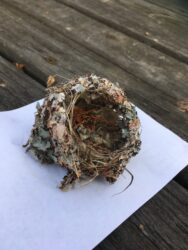
Have you ever noticed that animals make art? Many species are crafty, but birds are among the most wondrous of artisans! You may be wondering how birds can be considered artistic; after all, these creatures do not have opposable thumbs! The answer lies in the nests that birds create for both home and shelter.
Are your eyes ever drawn to these artistic structures? Whether you live in the city or rural area, there are almost certainly bird nests in the vicinity! Take a moment to peek out your window; do you see any nests? There are several varieties of bird nests that you may encounter, both at home and in wild spaces. The types of nests that are made are largely dependent on species and location. After reading this Discovery Blog, you will be encouraged to venture outside to see if you can spot a few of the avian shelters that are discussed here. Finally, following your observation time, it will be your turn to create a nest!
Nests act as both a home and a shelter. Every species of bird has their own technique for crafting a nest, and nearly every kind of material is used across the feathered world! Most often, you will see cupped nests. These are shaped like bowls, and chances are, there is at least one close by! Cupped nests are fascinating to observe because they are typically woven and can evoke comparisons to the traditional basket weaving practiced by Indigenous and folk artists.

Depending on the bird species, their nest may be made of various items. Twigs, grasses, spider silk, and even hair can be found woven into nests! The first three materials listed are probably what you expected, but what about hair? Where might a bird gather that from? In areas where horse farms are nearby, birds have been known to collect horsehair! Similar to the grass and spider threads used, horsehair is both flexible for weaving and helps to insulate the nest, keeping all of the eggs and chicks warm and cozy.
You can find nests in dozens of sizes, from the enormous eyries of eagles (about the size of a tractor tire), to the miniature bowls that hummingbirds craft (around the size of a walnut). Some nests are rather plain, while others are decorated! For example, let’s return to hummingbirds: these tiny, feathered jewels use lichen to adorn their homes! Why do you think that hummingbirds make this artistic choice? Yes, lichen makes a nest look even prettier, but it also provides the shelter with fantastic camouflage!

The nests introduced in this blog post are only a few of the most commonly found varieties in Kentucky. There are many others which can be found around the world. When you venture outside in a few minutes, see how many kinds of nests you can spot!
Before your observation and crafting time, let’s recap. Just like human fingerprints, all bird nests are unique. They are pieces of natural art created by spectacular architects, each one as individual as people are! From now on, every time you go outside, try to pay attention to the nests nearby. Try to think of your next neighborhood walk as a wander through an outdoor art gallery. By observing these nests, their artistry, and their residents, you will soon be able to recognize your local birds as your neighbors!
Your Turn! (Observation and or Craft Prompt): Go outside and see how many bird nests you can find! Make sure to maintain a hands-off approach, not handling or getting too close to the nests. Inspired by your observations, after a minimum of fifteen minutes, it will then be time to unleash your own artistic skills! Using materials that you can find around your home, create a nest that you would want to live in if you were a bird! Natural materials like mud and grass can be used, but if you prefer, non-natural materials (such as Play-Doh) will work too! Like the birds, utilize whatever items are available! Be sure to remain purposeful in your choices. Think about what role your materials, the size and shape of your nest, and the location will play in the creation of a successful shelter and egg incubator!

